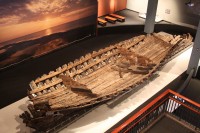 After 17 years, restoration of the hull of La Belle, one of four ships that carried French explorer René-Robert de La Salle and 300 would-be colonists on his mission to the Gulf of Mexico, is finally complete.
After 17 years, restoration of the hull of La Belle, one of four ships that carried French explorer René-Robert de La Salle and 300 would-be colonists on his mission to the Gulf of Mexico, is finally complete.
La Belle was a 54-foot frigate that could navigate open ocean but was had a shallow enough draft that it could hand coastal and river waters as well, an essential design for this trip since La Salle’s aim was to found a colony in the Mississippi River Delta. Their poor maps of the Gulf sent the explorers way off course. When his main storeship, L’Aimable, ran aground, La Salle was compelled to transfer as much of her contents as he could salvage to La Belle, so when a storm claimed her too off the coast in Matagorda Bay, 400 miles west of the Mississippi Delta, in 1686, she sank with a disproportionately huge complement of artifacts and supplies.
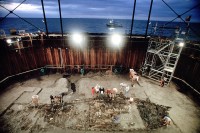 That gave the Texas Historical Commission archaeologists who discovered the wreck in 1995 a lot of work to do. They built a double-walled cofferdam around the wreck, pumped out the water and from September of 1996 to April of 1997, excavated the surviving bottom third of the ship’s oak hull. By the end of the excavation they had recovered nearly 1.6 million objects — barrels of gunpowder, weaponry, personal items, cookware, crates full of trade geegaws (brass rings, pins, hundreds of thousands of glass beads).
That gave the Texas Historical Commission archaeologists who discovered the wreck in 1995 a lot of work to do. They built a double-walled cofferdam around the wreck, pumped out the water and from September of 1996 to April of 1997, excavated the surviving bottom third of the ship’s oak hull. By the end of the excavation they had recovered nearly 1.6 million objects — barrels of gunpowder, weaponry, personal items, cookware, crates full of trade geegaws (brass rings, pins, hundreds of thousands of glass beads).
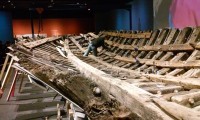 The hull was sent to Texas A&M University’s Nautical Archaeology Program where the timbers were soaked in a bath of polyethylene glycol (PEG) solution, a petroleum-based polymer that replaces the water in wood to keep it from warping, cracking or shrinking when it dries, for 10 years. When the high price of oil made the use of PEG prohibitively expensive, conservators put the timbers in the largest archaeological freeze-dryer in the world. After four years in the freezer, in the summer of 2014 La Belle‘s timbers were transported to the o the Bullock Texas State History Museum in Austin. There they were reassembled in a side gallery where the process could be viewed by the public.
The hull was sent to Texas A&M University’s Nautical Archaeology Program where the timbers were soaked in a bath of polyethylene glycol (PEG) solution, a petroleum-based polymer that replaces the water in wood to keep it from warping, cracking or shrinking when it dries, for 10 years. When the high price of oil made the use of PEG prohibitively expensive, conservators put the timbers in the largest archaeological freeze-dryer in the world. After four years in the freezer, in the summer of 2014 La Belle‘s timbers were transported to the o the Bullock Texas State History Museum in Austin. There they were reassembled in a side gallery where the process could be viewed by the public.
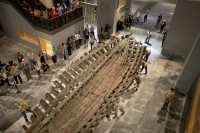 In May of 2015, reassembling of the timbers was complete and the entire hull was moved to the main gallery of the museum, its final resting place after 20 years of upheaval. While the hull timbers were back together again, the restoration wasn’t finished yet. The were gaps that needed to be closed and additional surviving sections of the hull added to the structure. While conservators were working on that, the main gallery was refurbished around the ship’s hull to create the permanent exhibition that would fully showcase La Belle and its many artifacts.
In May of 2015, reassembling of the timbers was complete and the entire hull was moved to the main gallery of the museum, its final resting place after 20 years of upheaval. While the hull timbers were back together again, the restoration wasn’t finished yet. The were gaps that needed to be closed and additional surviving sections of the hull added to the structure. While conservators were working on that, the main gallery was refurbished around the ship’s hull to create the permanent exhibition that would fully showcase La Belle and its many artifacts.
The restoration is now complete and the ship positioned at a 21-degree angle, just as it was on the sea floor when archaeologists excavated it. The temporary exhibition La Belle: The Ship That Changed History, is ongoing now. The permanent exhibition is scheduled to open in November, after which some of the artifacts from the wreck will become part of a traveling exhibition that will visit several locations in the United States and France, which is still the legal owner of La Belle and everything on it.
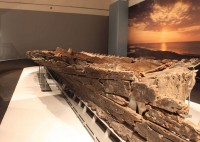
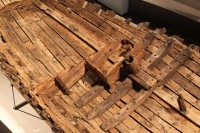
Great find, wonderfully displayed.
Wikipedia: On April 9, 1682, at the mouth of the Mississippi River near modern Venice, Louisiana, La Salle buried an engraved plate and a cross, claiming the territory for France.
828,000 square miles [that Thos. Jefferson] bought from France in 1803 for…a total of sixty-eight million francs ($15,000,000 USD).
That’s a lot of modern day euros.
Thanks for a great story! I didn’t even know the ship had been discovered.
I can still vividly recall building a diorama depicting the wreck of La Salle’s ship in Matagorda Bay for my 7th grade Texas history class project. Building the ship out of balsa was fun, but trying to make storm waves out of paper mache was very frustrating.
The ship and its contents still belong to France? How does that work?
The ship that was found offshore ‘Matagorda Bay’ might be French, but isn’t ‘Matagorda‘ Spanish for ‘Fat Bush’, and if so, what is ‘Matagorda’ in French ?
Why did the former US buy in 1803 from the French, while in the late 18th Century -as they had done so already in the 17th- the Spanish constructed several missions ? The French mission had apparently not been a successful one.
—————-
“In 1749, the Spanish peace treaty with the Lipan Apache angered many tribes, including the Comanche, Tonkawa, and Hasinai. The Comanche signed a treaty with Spain in 1785 and later helped to defeat the Lipan Apache and Karankawa tribes.”
“In 1821, the Mexican War of Independence included the Texas territory, which became part of Mexico. Due to its low population, Mexico made the area part of the state of “Coahuila y Tejas”. Combined with United States’ attempts to purchase Texas, Mexican authorities decided in 1830 to prohibit continued immigration from the United States [into Texas].”
“The Texas Revolution from 1835/1836 began when primarily US colonists in the Mexican province of Texas rebelled against the increasingly centralist Mexican government.”
:confused:
Well done article about returns on the money spent on the Louisiana Purchase, Manhattan and Alaska:
https://mises.org/library/what-rate-return-louisiana-purchase
“Why did the former US buy in 1803 from the French, while in the late 18th Century -as they had done so already in the 17th- the Spanish constructed several missions ? The French mission had apparently not been a successful one.”
Because Napoleon had stolen the Spanish territory by virtue of invading Spain.
Thanks dearieme, I reckon that kind of makes sense to me. I was having a look at Goya’s “Los desastres de la guerra” (the Disasters of War), in which context it reads: “Under the guise of reinforcing the Spanish armies, 23,000 French troops entered Spain unopposed in November 1807”, i.e they invaded Spain a little later than 1803.
What I noticed was that Royal French agents covertly influenced what, between 1765 and 1783, would become the “American Revolution”, while the “French Revolutionary Wars” from 1792 to1802, resulted from the “French Revolution”. By 1795, the French had captured the Austrian Netherlands and knocked Spain and Prussia out with the Peace of Basel.
The Second Treaty of San Ildefonso was signed on 19 August 1796 between Spain and the First French Republic. Based on the terms of the agreement, France forced Spain to become “allies” and to combine their forces, you might recognize a pattern here, against the British. As we do know now, the French messed it all up but could apparently sell in 1803. Thus, the US gave some money to kick Spain out.
*Three hundred years after its sailing, the French government made claim to the shipwreck and all its contents, based on the International Law of the Sea, a doctrine which gives ownership of official naval vessels to the “flag nation,” the country whose flag the ship flies. In 2003, however, following negotiations between the THC, Secretary of State Madeleine Albright, and representatives of the French government, a treaty was signed conceding ownership to France but giving day-to-day care of La Belle to the Texas Historical Commission.*
http://www.texasbeyondhistory.net/belle/index.html
A 54 footer is a sloop not a frigate! If the French could claim this ship, why didn’t the Spanish claim the Atocha!?